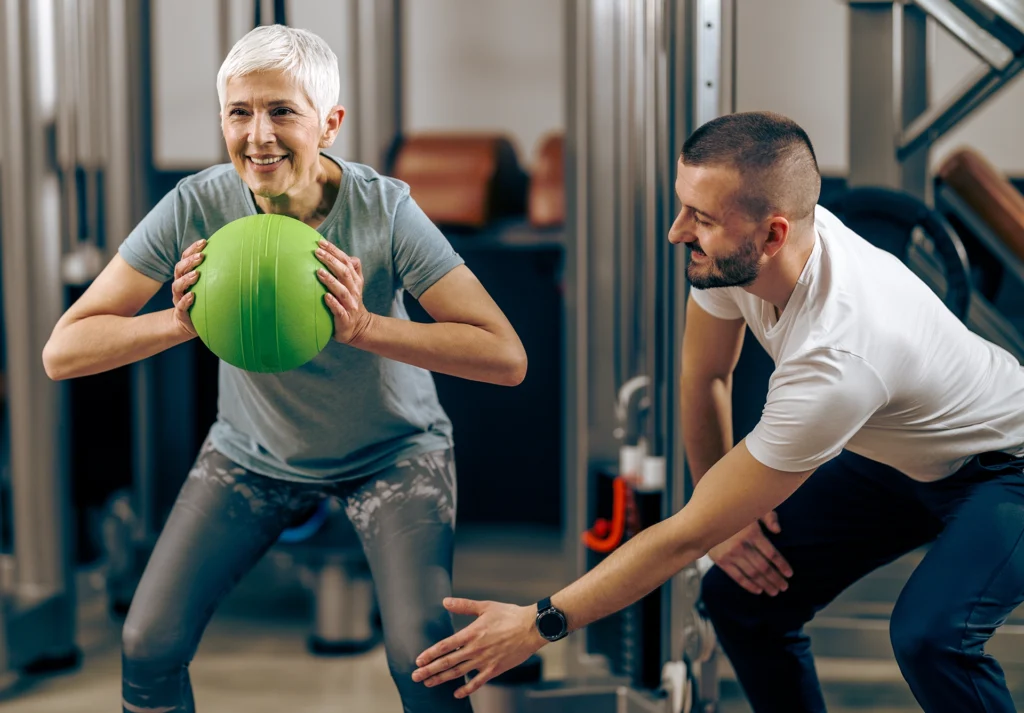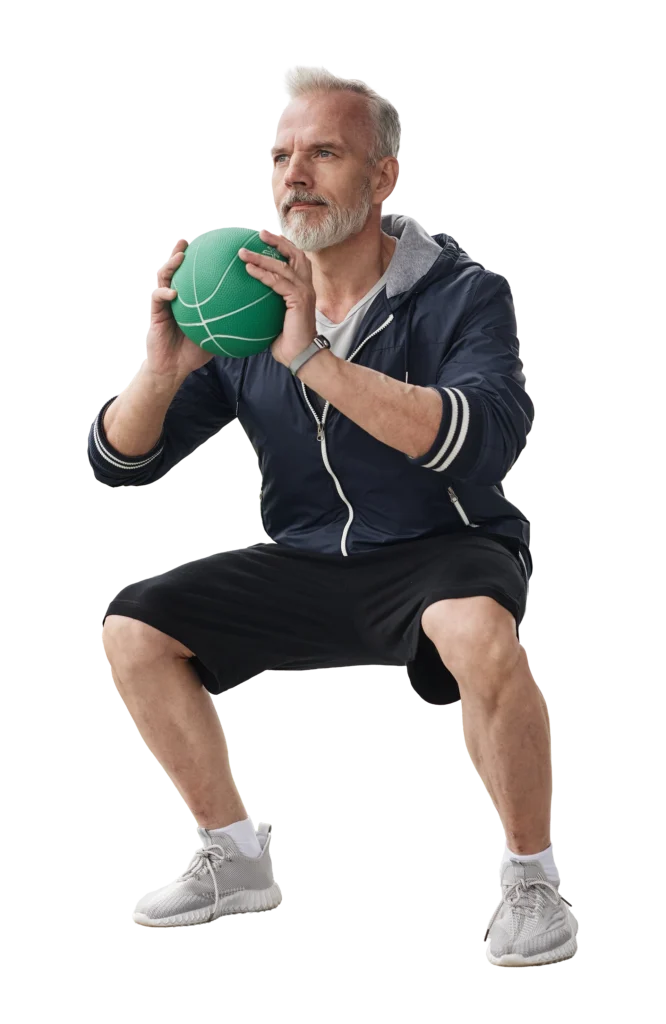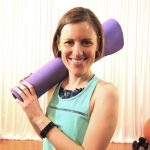Older Adults
More Than Dumbbells: Small Ball Training for Older Adults

As group fitness instructors working with older adults, we’re constantly seeking equipment that’s accessible, affordable, and effective. While dumbbells remain a staple for strength training, small soft balls (mini balls, toning balls, or agility balls (typically 18 to 23 centimetres or 7 to 9 inches in diameter) offer unique neurological and functional benefits that dumbbells cannot replicate.
The research is clear: ageing brings specific declines in tactile sensitivity, reaction time, eye-hand coordination, and multi-directional movement capacity. Small ball exercises address all of these simultaneously – making them one of the most efficient tools in your programming arsenal.
The Science of Ageing: What We're Working Against
Tactile Sensitivity Decline
As we age, tactile sensitivity decreases, affecting our ability to manipulate objects safely and effectively. This decline impacts everyday activities like buttoning clothes, handling coins, gripping utensils, and feeling texture differences that signal slippery or hot surfaces.
Gripping and manipulating a soft ball provides tactile stimulation that helps maintain hand sensitivity to touch, pressure, and texture. This regular sensory input supports both peripheral nerve function and the somatosensory cortex – the brain region responsible for processing touch information.
IN CLASS: If possible, incorporate varied ball textures (e.g., smooth, spikey) and encourage different grip pressures throughout your class. Encourage participants to notice the sensation: “Feel the ball compress in your palm,” or “Notice how the texture changes as you squeeze.”
Grip Strength Deterioration
Research shows grip strength declines steadily with age – approximately 5 to 6kg every 10 years for men and 3 to 4kg for women after age 60, with the rate of decline accelerating in the mid-70s. For context, that’s enough loss over two decades to make the difference between confidently carrying groceries and struggling with a single bag.
Weak grip strength isn’t just about carrying shopping or opening jars – it’s a powerful predictor of overall health, mobility limitations, and mortality risk in older adults. Studies have linked poor grip strength to increased fall risk, reduced independence, and even cardiovascular disease, making grip training essential for longevity.
IN CLASS: Unlike dumbbells that require a minimum grip strength to hold safely, soft balls can be squeezed with whatever force the participant can generate. This makes them ideal for deconditioned participants or those with arthritis. Progress from gentle squeezes to dynamic squeeze-and-release patterns, then add movement while maintaining the squeeze.
Reaction Time Slowing
An analysis of MindCrowd data showed that the average reaction time slows by seven milliseconds per year. Age is the biggest factor, but other contributors include smoking, dizziness, medications, and Alzheimer’s disease in the family.
These milliseconds matter. When someone trips, they have less than 200 milliseconds to generate the maximal muscle strength needed for balance recovery. Slower reaction time is the difference between catching yourself and hitting the ground.
IN CLASS: Ball exercises that require quick catches, tosses, or rapid direction changes train exactly these split-second responses. Start with predictable patterns (self-toss and catch), progress to partner tosses at varying speeds, and advance to catching while performing another movement (stepping, turning, or sitting to standing). This trains the rapid decision-making and motor response needed for fall prevention.
Eye-Hand Coordination Impairment
As we age, our ability to coordinate what we see with how we move declines. This happens because we lose sensitivity in how our body senses its position in space, and the nerve cells that transmit visual information decrease, both contributing to poor eye-hand coordination.
This matters because impaired eye-hand coordination is associated with symptoms of early-stage cognitive decline, and severe impairment affects the ability to perform activities of daily living, including bathing, dressing, exercising, and writing.
IN CLASS: Ball exercises are cognitive training disguised as physical exercise. Activities like tracking a moving ball, catching and tossing to targets, or coordinating ball movements with footwork patterns challenge the brain-body connection. Progress from large, slow movements to smaller, faster, more complex patterns.
What Balls Do That Dumbbells Can't
Constant Active Grip
While a dumbbell handle provides a passive grip surface, a soft ball requires active, continuous squeezing throughout the exercise. This sustained contraction:
- Engages the forearm flexors and intrinsic hand muscles constantly
- Trains the grip endurance needed for carrying groceries or holding handrails
- Provides proprioceptive feedback throughout the entire range of motion.
Instructor Tip:
Encourage participants to "squeeze the ball like you're trying to get juice out of it”. This increases muscle activation and helps participants with neurological grip awareness.
Multi-Directional Movement Capacity
Dumbbells are designed for linear, gravity-dependent movements: up/down, forward/back. Balls excel at:
- Rotational movements: Twisting the torso while holding the ball
- Diagonal patterns: Reaching across the body in functional patterns
- Rolling movements: Rolling the ball along limbs or surfaces for self-massage and proprioception
- Circular patterns: Moving the ball in figure-8s or circles overhead.
These movement patterns replicate real-world activities like reaching into the back seat of a car, putting dishes away on varied shelf heights, or twisting to look behind you while walking.
Instructor Tip:
Create ‘functional movement flows’ that combine multiple directions. For example: “Hold ball at chest, rotate right, reach ball down toward right hip, lift diagonally across body to overhead left, circle down and repeat”. This trains movement patterns, not just muscles.
Adaptable Resistance and Comfort
A soft ball moulds to the hand, making it ideal for participants with:
- Arthritis or joint pain in the hands
- Reduced grip strength who can't safely hold dumbbells
- Neuropathy or sensitivity issues
- Fear of dropping heavy objects.
The resistance is self-selected – participants can squeeze harder for more challenge or lighter for comfort, all while performing the same movement pattern as the group.
Instructor Tip:
Offer balls of different sizes and firmness levels. A slightly deflated ball is easier to grip for those with severe hand limitations, while a fully inflated ball provides more resistance.
Dual-Task Training
Ball exercises naturally create dual-task scenarios: participants must track the ball visually while coordinating movement, maintaining balance, and controlling grip pressure simultaneously. This cognitive-motor challenge is valuable as falls often occur during dual-tasking (walking while talking, carrying something while navigating stairs).
Research shows that sedentary older adults have to use more and more brain power to sense where their body is in space – especially when doing two things at once. Ball exercises train exactly this skill.
Instructor Tip:
Layer complexity progressively. Start with ball squeezes while marching in place, advance to ball tosses while stepping side to side, then add directional changes or partner work. Each layer increases the cognitive demand.
Proprioceptive Training
Everyone relies more on body sense than vision to stay balanced. But this body sense – especially in the ankles – peaks when we’re young adults and becomes least sensitive after age 75. Studies show the sensors in our muscles lose about 30% of their function as we age.
Ball exercises provide rich proprioceptive input through:
- Variable grip pressures
- Tracking the ball's weight and position in space
- Coordinating ball position with body position
- Feeling the ball's compression and release.
Instructor Tip:
Include exercises where participants close their eyes while manipulating the ball (if balance allows), pass the ball behind their back, or place the ball between body parts (between knees, under one foot, behind the lower back against a wall) to increase proprioceptive challenge.
Making the Case to Your Participants
When introducing ball work to your older adult classes, help them understand the ‘why.’
“We’re adding ball exercises because they train your body in ways that dumbbells can’t. Every time you squeeze, catch, or toss this ball, you’re training the quick reactions you need to catch yourself from a fall, the eye-hand coordination you need for daily tasks like pouring coffee or using your phone, and the grip strength you need to open jars and hold onto railings. Plus, all that squeezing and coordinating is a great workout for your brain, too.”
Conclusion
Small balls aren’t a replacement for dumbbells – they’re a complementary tool that addresses specific age-related declines that dumbbells don’t target. By incorporating ball work into your programming, you’re providing training that translates directly to fall prevention, functional independence, and cognitive health.
The equipment is inexpensive, accessible, and adaptable to all fitness levels. But the real reason to add balls to your toolkit? The research is clear: they train the neurological and functional capacities – reaction time, eye-hand coordination, grip strength, and proprioception – that can keep older adults safe and independent in their daily lives. And isn’t that what we all want?

- References
- Bohannon R. W. (2019). Grip Strength: An Indispensable Biomarker For Older Adults. Clinical interventions in aging, 14, 1681–1691.
- McIntyre, S., Nagi, S. S., McGlone, F., & Olausson, H. (2021). The Effects of Ageing on Tactile Function in Humans. Neuroscience, 464, 53–58.
- TGen. (2025). A variety of factors beyond age influence reaction time. Neuroscience News. Retrieved October 31, 2025
- Wickremaratchi, M. M., & Llewelyn, J. G. (2006). Effects of ageing on touch. Postgraduate medical journal, 82(967), 301–304.

Trudi Edmeades
Trudi Edmeades is the co-founder of Third Age Fitness, an organisation that focuses on training professionals in all aspects of older adult fitness. Their online course, Standing Bodyweight for Older Adults, includes over 180 equipment-free exercises that can be combined with cognitive challenges for older adults and seniors.